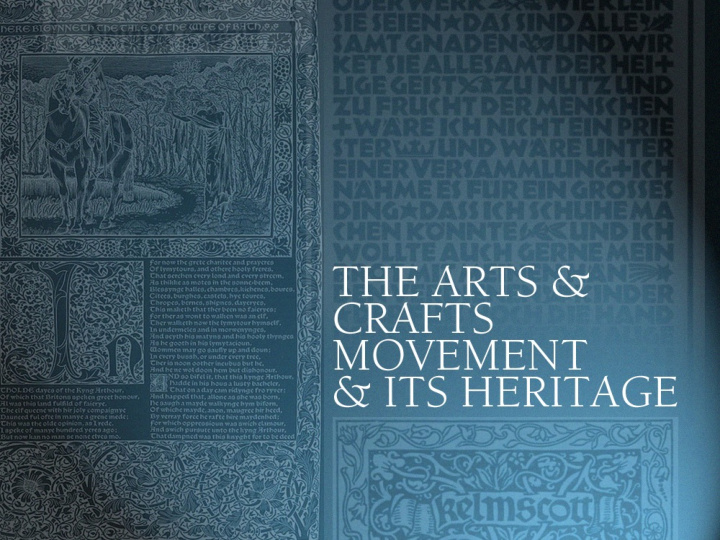



John Ruskin The writer and art critic inspired the philosophy of the Arts and Crafts Movement. Ruskin saw mass- produced goods as “cheap and nasty.” His philosophy was that beautiful things were valuable and industrialization stifles creativity.
William Morris became the leader of the Arts and Crafts Movement — an artist and textile designer, he rejected the poor quality mass productions of the Industrial Revolution.
William Morris Born into wealth, he had his architect friend Philip Webb build The Red House for him and his wife.
William Morris He was disappointed in the poor quality of manufactured furniture at the time so he began to design his own. He is best known for his intricately detailed patterns and designs for fabrics and textiles.
William Morris He spent several years designing the furniture, tapestries and stained glass windows for Red House.
William Morris Established his first art-decorating firm in 1861 devoted to craftsmanship and quality.
William Morris designed from a love of nature and an admiration for art from the 15 th century.
William Morris was deeply concerned over problems associated with factories and industrialization.
A socialist , Morris believed that when artists and craftsmen combine to make beautiful objects … workers would find joy in their work again.
Morris was appalled by the proliferation of signboards and posters all across the rural countryside and false claims on packages and ads.
Morris founded the Society for Checking the Abuses of Public Advertising to regulate their claims.
Morris founded the Society for Protection of Ancient Buildings in 1877. It is the oldest architectural preservation society, dedicated to the original craftwork and restoration. He was outspoken against remodels and modernizations.
Arthur Mackmurdo was a young architect and designer when he met Morris. He too, disapproved of industrialized production.
Arthur Mackmurdo His flowing designs established a link to the Art Nouveau movement a decade before its conception.
The Century Guild was founded by Mackmurdo and included writer Herbert Horne and designer/illustrator Selwyn Image.
The Century Guild Hobby Horse was produced with painstaking care; this periodical introduced the Arts and Crafts movement to all of Europe.
Kelmscott Press Inspired by incunabula book design, William Morris starts his own private press.
William Morris designs three new typefaces for his books based on 15th century incunabula types.
Golden Morris designed this type using the Venetian roman typefaces of the Renaissance era.
Morris delved into the study of Gothic book design, instead using his Golden roman type.
Kelmscott Press Morris’s first book, The Story of the Glittering Plain , was published in 1894.
Troy Based on studies Peter Schoeffer’s Gothic types, Morris developed a new gothic typeface Troy and used it in his first book.
The Works of Geoffrey Chaucer was Morris’ masterpiece of book design, printed in 1896. It used the Troy typeface.
The Works of Geoffrey Chaucer featured 87 woodcuts, 14 large borders and 18 smaller frames around the illustrations.
Morris designed over 200 initial letters and words in The Works of Geoffrey Chaucer. He used a smaller version of his Troy type and called it Chaucer .
Kelmscott Press Essex House Press Doves Press The Private Press Movement These independent print houses were mainly concerned with high standards of design, materials and workmanship. Their books were considered works of art.
The Doves Press Bible, 1903 Considered a masterpiece for its Essex House Press purity of design and craftsmanship.
The Doves Press Bible, 1903 Bookbinder T.J. Cobden-Sanderson and printer Emery Walker shared the view that “the whole duty of Typography is to communicate to the imagination, without loss by the way, the thought or image intended to be conveyed by the Author.”
The Doves Press Bible, 1903 The book’s design was spare and obsessively focussed on pure typography. Dove’s type was based on the early renaissance Old Style roman type of Nicolas Jenson.
A book-design renaissance: France Lucian and Esther Pissarro, 1903 Ishtar’s Descent to the Nether World
A book-design renaissance: Netherlands Jan van Krimpen, 1920 Deidre and the sons of Usnach
A book-design renaissance: Netherlands S. H. De Roos, 1929 Hand and soul
A book-design renaissance: Germany Rudoph Koch, 1922-23, was a master calligrapher and designer of gothic fonts.
A book-design renaissance: He created this unexpected new design, the rough- hewn and chunky Neuland in 1922.
A book-design renaissance: America Frederic Goudy, 1911 A freelance designer, Goudy designed a total of 122 typefaces, many based on Venetian and French Renaissance type designs
A book-design renaissance: America Bruce Rogers graduated from college in the 1890s, where he was a campus artist. He worked as a newspaper illustrator, magazine designer and joined the Riverside Press in 1896 as book designer.
A book-design renaissance: America In 1912 Rogers left The Riverside Press to freelance — creating a typeface for for the New York Museum of Art and consulting for several university presses.
A book-design renaissance: America Bruce Rogers, 1915 The Centaur is one of Rogers’ most elegant book designs. Inspired by Morris, he created the typeface Centaur and illustrated the initials in the French Renaissance style.
A book-design renaissance: America Rogers had outstanding sense of design judgment. He determined the usefulness of a design element or decoration by whether the page was better served with or without it.
Recommend
More recommend